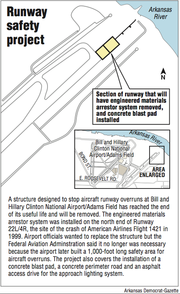A structure designed to stop aircraft overruns that was installed at the state's largest airport after the crash of American Airlines Flight 1420 in 1999 is at the end of its useful life and is scheduled to be removed.
The Federal Aviation Administration no longer considers the arresting system necessary because Bill and Hillary Clinton National Airport/Adams Field later added a 1,000-foot-long safety area at the north end of Runway 22L/4R, according to airport officials.
Ron Mathieu, the airport's executive director, said Wednesday that he had asked the federal agency to help replace the system, but his request was rejected because the safety area is considered the industry standard. The safety structure designed to stop aircraft overruns is required only when a nonstandard safety area exists, he said.
"But I felt we needed to do both," he said at a meeting Wednesday of the Little Rock Municipal Airport Commission's lease committee.
Mathieu left open the possibility that the commission could pay for a new arresting system, something that Commissioner Tom Schueck said he likely will propose later.
"Seeing the history we have there, I possibly will recommend that," Schueck said in an interview after the meeting, referring to the Flight 1420 crash. "Why wouldn't you do that? How many lives could you save?"
On the night of June 1, 1999, the pilot and 10 passengers died after the regularly scheduled flight between Dallas/Fort Worth International Airport and Clinton National overshot the runway while landing during a thunderstorm.
The other crew members and 105 passengers received serious or minor injuries; 24 passengers escaped unhurt. The MD-82 airliner was destroyed by impact forces and a post-crash fire.
After overrunning the end of the runway, the airplane struck part of the instrument landing system 411 feet away, passed through a chain-link security fence, went down a rock embankment to a flood plain 15 feet below the runway, struck the approach light system and came to rest about 800 feet from the end of the runway, according to an FAA account of the crash.
The installation of the engineered materials arresting system, which is designed to "catch" an aircraft that either doesn't stop fast enough or lands too far down the runway, already was in the airport's plans at the time of the crash.
The engineered material, often light concrete, causes the tires of the aircraft to sink as it rolls through the material, forcing the aircraft to decelerate, according to the FAA.
The structures are installed at the ends of 79 runways at 49 airports in the United States, according to the FAA, which has plans to install 13 more such structures at nine more U.S. airports. Since the technology was developed in the 1990s, the FAA said, the structures have stopped nine overrunning aircraft with a total of 243 crew and passengers aboard.
The system to be removed at Clinton National is the oldest first-generation system still in operation in the United States, airport officials said. A second such system installed later on the south end of Runway 22R/4L already has been rehabilitated once. It is designed to "catch" aircraft before they run onto East Roosevelt Road.
The engineered materials arresting system that is being removed was rendered obsolete when the airport used sand and other fill from the nearby Arkansas River to build out the additional land required for a safety area. The date and cost of that project wasn't available Wednesday.
Removing the arresting system is only one aspect of the project in the runway safety area on the north end of Runway 22L/4R, which is on the east side of the airport.
The project, which is estimated to cost $1.8 million, will also include the installation of a concrete blast pad, which is designed to protect the end of runways from the effects of jet-engine thrust that could erode the land in close proximity to the runway while aircraft are landing and taking off.
A concrete perimeter road also would be built to replace the gravel road there now. An asphalt drive to access the approach lighting system also would be constructed.
Garver LLC, one of the airport's two consulting engineering firms, got the assignment. The firm agreed to do surveying, geotechnical and design services to prepare the bid documents under an agreement that wouldn't exceed $132,000. The FAA is expected to cover 90 percent of the cost of the project.
Metro on 09/11/2014
